Effectiveness of entomopathogenic fungal strains against poplar/willow weevil (Cryptorhynchus lapathi L.) larvae
Fang Niu·Ya Xing·Niya Jia·Kai Ding·Dan Xie·Huanwen Chen·Defu Chi
AbstractThe poplar and willow weevil,Cryptorhynchus lapathi L.,a major universally destructive wood-boring insect has become one of the important quarantine pests that is extremely destructive to forestry development and needs to be controlled.Entomopathogenic fungi (EPF) are considered safe and friendly for humans and the environment and play important roles in controlling insect pest populations.In this study,the screening of entomopathogenic fungi for control of C.lapathi is reported through the evaluation of virulence of four fungal Beauveria bassiana(CFCC81428,CFCC83116,CFCC83486,CFCC87297)strains,one B.brongniartii (CFCC83487) strain and one Metarhizium anisopliae (CFCC88953) strain.The virulence of the different strains was appraised by correct mortality rate,cumulative mortality rate,median lethal concentration(LC50) and median lethal time (LT50).B.bassiana strains CFCC81428 and CFCC83116 were the most virulent among the six strains with a mortality up to 100%,and the LT50 were 2.7 and 3.1 days.Five conidia concentrations of three strains (CFCC81428,CFCC83116 and CFCC87298) that caused high virulence was screened for dose-relationship.Their effect on controlling C.lapathi larvae were also determined under field condition by brushing conidia suspensions on C.lapathi larvae infested in a poplar trunk.The cumulative rate in the field was lower than those obtained from the laboratory,but the order of the virulence of different strains did not change.Mortality in all three strains occurred at their highest concentration (1.0×108 conidia mL-1).Under field conditions,the CFCC81428 strain was the most effective,causing mortalities of 80.3% and 75.2%in two plots in Beipiao and Lindian counties,respectively,followed by CFCC83116 (69.1%,66.6%) and CFCC87298(60.7%,59.3%).Based on our results,the B.bassiana strain CFCC81428 has the potential as a biological insecticide to control C.lapathi larvae.
KeywordsEntomopathogenic fungi·Pathogenicity·Biocontrol control·Beauveria bassiana ·Cryptorhynchus lapathi
Introduction
The poplar and willow weevil,Cryptorhynchus lapathiL.(Coleoptera:Curculionidae) is a destructively universal wood-boring insect pest whose larvae damage species of the Salicaceae tree family.This weevil is widely distributed in Asia,North America and most European countries.In recent years,species ofPopulusandSalixhave been seriously damaged in many provinces of China such as Heilongjiang,Jilin,Liaoning and Inner Mongolia (Cao et al.2015).The risk assessment result of economic losses caused byC.lapathiin China have been estimated to be 273.12 billion CNY (42.7 billion dollars) per year (Ji 2015).Despite weak active diffusion capacity,the insect relies on the transfer of infested plants for long-distance transmission (Yang et al.2019).This weevil was listed as a forest quarantine pest by the State Forestry Administration of China over a number of years,beginning in 1984 (Zou et al.2019).Several countries,including Canada,the United States,France and Japan regard it as a dangerous pest to be quarantined (Jia 2015).Each larval instar causes severe damage to the host tree;the first chews into the bark,the second bores tunnels around the trunk,damaging the phloem and cambium,and the third bores into the xylem (Broberg et al.2006,2010).The larvae cut offthe conducting tissues completely,leading to the death of the trees due to lack of nutrients and water,which also results in stem breakage,pathogen entry and decline in wood quality,resulting in considerable economic losses(Broberg et al.2005).
Chemical pesticides with different active substances applied as either trunk injection or spray,as well as fumigation treatments,are still the main control techniques forC.lapathi(González-Mas et al.2019;Wang et al.2019).Studies over the past decades have shown that pesticides applied to forest stands increased insect resistance,promoted secondary pest population resurgence and caused environmental pollution (Martin and Hyde 2001).This has prompted researchers to look for alternatives to chemical control.
Entomopathogenic fungi (EPF),as alternatives to chemical insecticides,play important roles in integrated pest management (IPM) (Bayındır et al.2020),and function in controlling the growth and decline of insect pest populations(Myrand and Buffet 2015).EPF usually attack the pest by penetrating the insect’s cuticle and producing toxins to attack the immune system of the host,and can be used as a potential biological control agent against to C.lapathi(Wakil et al.2013).Species in the generaBeauveriaandMetarhiziumare the most common and important EPF used to control different insect pests,including beetles,weevils and other insects and arachnids (Lin et al.2011;Behie et al.2015;Castrillo et al.2020).It has been reported that isolates ofBeauveria bassianaandMetarhizium anisopliaehad pathogenic effects on the Macadamia seed weevil,Kuschelorhynchus macadamiaeJennings and Oberprieler (Khun et al.2020).Ding et al.(2015) found thatB.bassianaandB.brongniartiiwere highly pathogenic onXylotrechus rusticusL.and that the pathogenicity of different fungal strains was different.Entomopathogenic fungi may provide more potential as a biological control agent against pests such asC.lapathi.
The present study was conducted to investigate the pathogenicity of different concentrations ofB.bassiana,B.brongniartiiandM.anisopliaestrains againstC.lapathilarvae under laboratory and field condition.
Materials and methods
Collection and breeding of larvae
TheC.lapathilarvae were collected from the infected poplar at two different sites,Lindian County and Daqing City.The larvae were transferred to the Key Laboratory for Sustainable Forest Ecosystem Management of the Northeast Forestry University,Harbin.The larvae were removed the trunk and used after seven days of incubation at 26°C,75% relative humidity and darkness,then maintained in petri dishes fed with cornmeal:soy flour:water=5:1:5.Holes were poked at each diet for simulating tree holes.Healthy and uniformsized third instar larvae were used in the experiments.
Source of fungal isolates and preparation of conidia concentrations
All six fungal strains were obtained from BeNa Culture Collection,Beijing (Table 1) and grown on sporulation culture medium (2% Corn flour,1% wheat bran,0.3% KH2PO4,0.5% peptone,0.1%NH4NO3,0.1% MgSO4·7H2O,2% Agar powder) at 26±1°C in the dark for 10 days.The spores were lightly scraped with an inoculation needle into a 250 ml Erlenmeyer flask with an improved Martin culture medium (10 g L-1glucose,1 g L-1KH2PO4,0.5 g L-1MgSO4·7H2O,5 g L-1peptone) installed in the sterile operating table,and spores were multiplied in a shaker at 180 revolutions at 26°C in the dark for 7 days.A hemocytometer was used to calculate the concentration of the suspensions,and they were then diluted to a concentration of 1.0×108conidia mL-1using the 0.05% Tween-80 sterile solutions.

Table 1 Information of six entomopathogenic fungi
The selected highly pathogenic strains were diluted into 1.0×108,1.0×107,1.0×106,1.0×105and 1.0×104conidia concentrations using the 0.05% Tween-80 sterile solutions.The fungi were tested for pathogenicity to the larvae of C.lapathi.
Pathogenicity of six strains to C.lapathi larvae
The larvae were immersed in 0.05% Tween-80 sterile solutions with the suspension concentration 1.0×108conidia mL-1for 15 s by the six fungal strains and then incubated at 26±1°C,75±10% RH in the dark for seven days.The control group was treated with 0.05% Tween-80 sterile water with same culture conditions.Each ten treated larvae were placed into a 12-cm diameter petri dish with artificial diet,compacted and ten holes made for each larva.Twenty larvae were used in each group and experiments repeated in triplicate.Mortality was recorded daily for seven days.The LT50was calculated to screen out the highly virulent EPF strains for the next study.
The selected virulent fungal strains were diluted into 1.0×108,1.0×107,1.0×106,1.0×105and 1.0×104conidia concentrations using the 0.05% Tween-80 sterile solutions and tested on larvae by the same method as noted above.The LC50were calculated for the pathogenicity of the different strains.
Bioassay of pathogenicity of high virulent strains against C.lapathi larvae in two trial plots
The strains were diluted into 1.0×108,1.0×107,1.0×106,1.0×105and trial plots were carried out in Beipiao County(120.75° E,41.82° N),Liaoning Province (May 14 to June 14,2018) and Lindian County (124.89° E,47.32° N),Daqing City,Heilongjiang Province (May 27 to June 27,2018).Because Beipiao is at a lower latitude,f eild tests were conducted earlier.During the field tests,the highest temperature in Beipiao and Lindian was 34 ℃,and 35 ℃,respectively;the lowest was 4 ℃ and 5 ℃,respectively.There were twelve and eight rainy days at Beipiao and Lindian County,respectively,during experiment.
The high-virulentB.bassianastrains CFCC81428,CFCC83116 and CFCC87298 were into 1.0×108,1.0×107,1.0×106,1.0×105,and 1.0×104conidia mL-1using the same method described previously.The diluted suspensions of different concentrations were brushed on the larvaeinfected trunk of 3-year-old poplar seedlings (2 m below the ground),and 0.05% Tween-80 sterile solution was brushed on seedlings as a control.A knife was used to scratch above the wormhole to help the penetration of the diluted suspensions.It came to be fifteen trees for each treatment concentration,taking each five infected trees as a group,three groups in total.The distance between each treated plot was more than 10 m.One month after treatment,the treated trees harvested and transferred to the KLFPB,Northeast Forestry University.Treated spots were dissected and the number of living and dead larvae was counted to calculate larval mortality.
Statistical analysis
Cumulative mortality data from each trial were analyzed by variance (ANOVA) and compared by Duncan’s new multiple range test (DMRT).Corrected mortality (%)=(C1-C)/(100-C)×100%,whereC1 is the cumulative mortality andCthe cumulative mortality of the control (Xie et al.2019).The histogram of the cumulative mortality was prepared using the Origin 8.0 (Originlab,Hampton,Massachusetts.USA).
Results
Screening the high virulent fungi against C.lapathi larvae by cumulative mortality and its LT50
The cumulative mortality ofC.lapathilarvae treated by the six fungi strains are shown in Fig.1.Pathogenicity exhibited differently among the six fungal strains at a concentration of 1.0×108conidia mL-1.Larval mortality significantly differed among the strains (P<0.05).Twenty-four hours after treatment,the larvae began to die but the treatment in the CFCC81428 strain appeared to cause the highest cumulative mortality (P<0.05).Six days after treatment,morality was 100%.The death by the CFCC83116 and CFCC87298 strains maximized from the 2nd to the 5th day,and then slowed gradually.These two strains resulted in 100% and 95.8% mortality by day 7 (P<0.05),respectively.The larvae infected with the other three strains (CFCC83486,CFCC83487,CFCC88953) generally died between day 2 and day 4 but the cumulative mortality was less than 55%.Mortality continued to show a gradual increase from day 5 to day 7.The cumulative mortality of CFCC83486 and CFCC83487 reached 78.1%±3.5% and 84.4%±0.6%by the 7th day (P<0.05),significantly lower than the CFCC81428,CFCC83116 and CFCC87298 strains.The lowest total mortality,66.7%±2.9% was recorded with theM.anisopliaeCFCC88953 treatment on day 7.Therefore,the most effective strains were CFCC81428,CFCC83116 and CFCC87298.
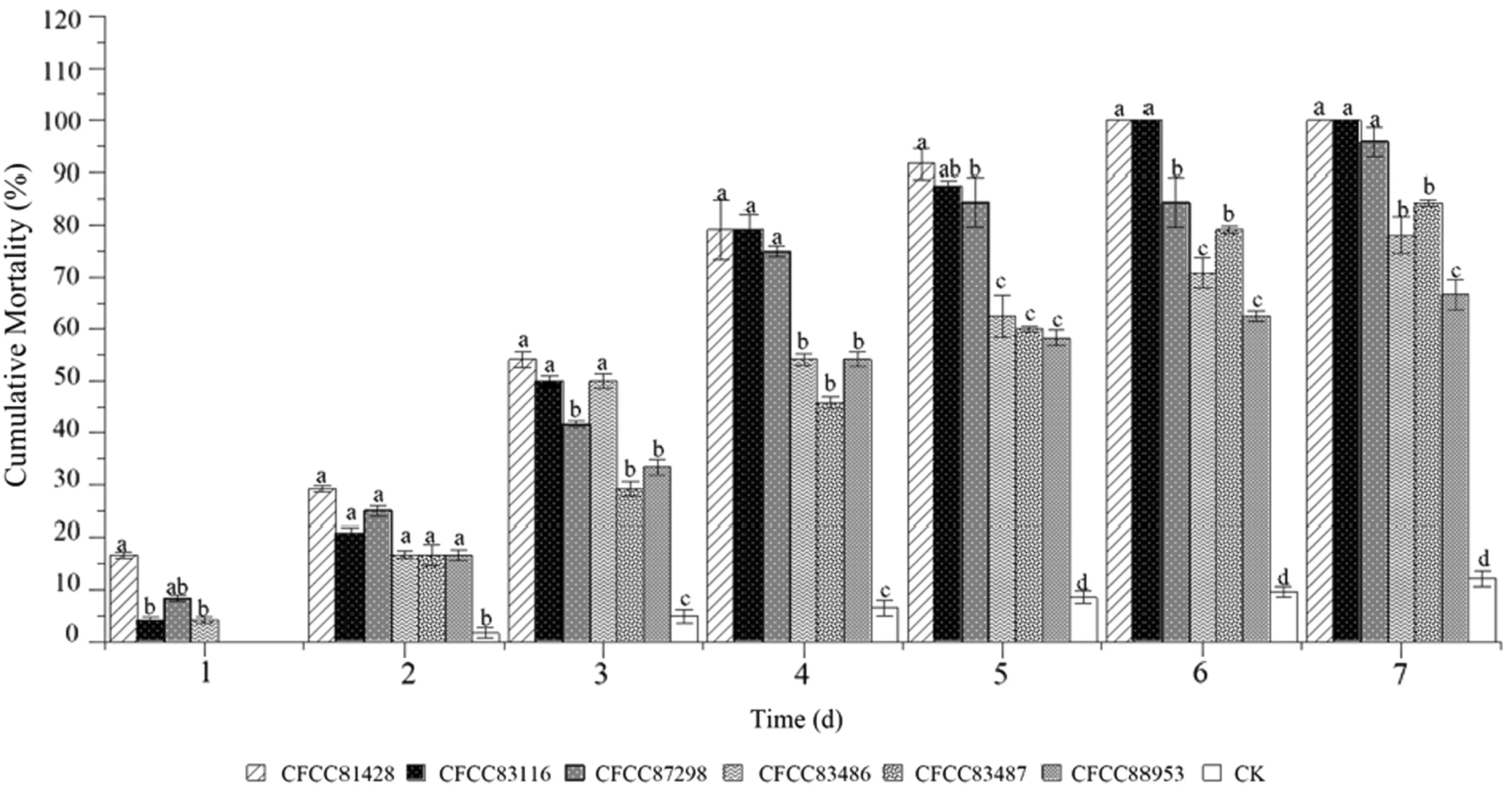
Fig.1 The cumulative mortality of C.lapathi larvae treated with six fungal strains;bars with different lowercase letters indicate significantly different (P<0.05).Note Time (day)
The LT50of the six fungal strains is presented in Table 2.The LT50ofB.bassianastrain CFCC81428 was 2.7 days,the shortest among theB.brongniartiiandM.anisopliaestrains.The LT50ofB.bassianastrains CFCC83116 and CFCC87298 were 3.1 and 3.3 days,respectively.The LT50of the other three strains (B.bassianastrain CFCC83486,B.bassianastrain CFCC83487,andM.anisopliaeCFCC88953) were more than four days.These results indicate that theB.bassianastrains CFCC81428,CFCC83116,CFCC87298 were rapidly pathogenic compared with the other three strains.The highest corrected mortality of CFCC81428 and CFCC83116 strains were up to 100%.The cumulative mortality of CFCC87298 was 95.8%±2.9%,and for the other three strains,less than 85%.
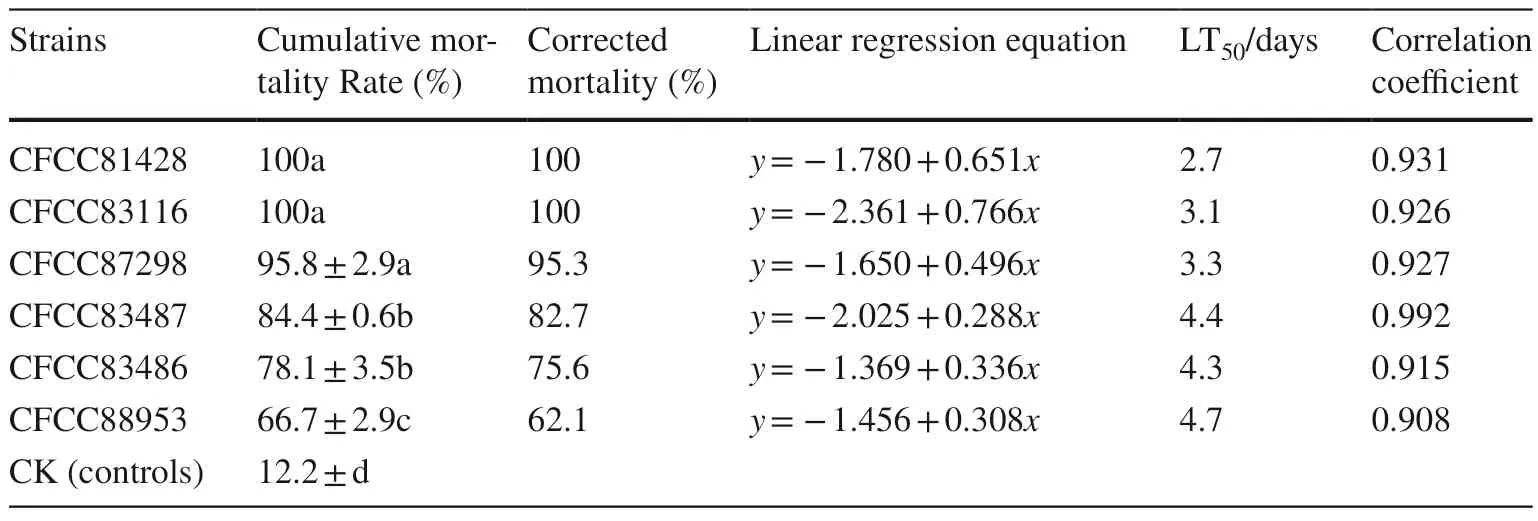
Table 2 LT50 and cumulative mortality of six entomopathogenic fungi to Cryptorhynchus lapathi larvae
Strains ofB.bassiana(CFCC81428,CFCC83116 and CFCC87298) were high pathogenic fungi based on cumulative mortality and LT50.
Different pathogenicity and LC50 of the high-virulent B.bassiana strains to C.lapathi larvae
Cumulative mortality rate and LC 50 of B.bassiana strain CFCC81482 at different concentrations
The cumulative mortality ofC.lapathilarvae treated with different concentrations ofB.bassianastrain CFCC81482 are shown in Fig.2.The cumulative mortality rate was positively correlated with increasing treatment time and spore suspension concentration.The cumulative mortality rate of the CFCC81428 with 1.0×108conidia mL-1suspension was significantly different with all other concentrations (P<0.05)except for 1.0×107conidia mL-1from day 5 to day 7,and the 1.0×106conidia mL-1on the 7th day.The CFCC81428 strain at 1.0×108and 1.0×107 conidia mL-1suspensions reached 100% mortality on day 6 and day 7,respectively.The cumulative mortality rate from the 1.0×106to 1.0×104conidia mL-1suspensions were 94.6%±1.2%,85.7%,71.4%by day 7,respectively,and also proved to be effective in lower concentrations.
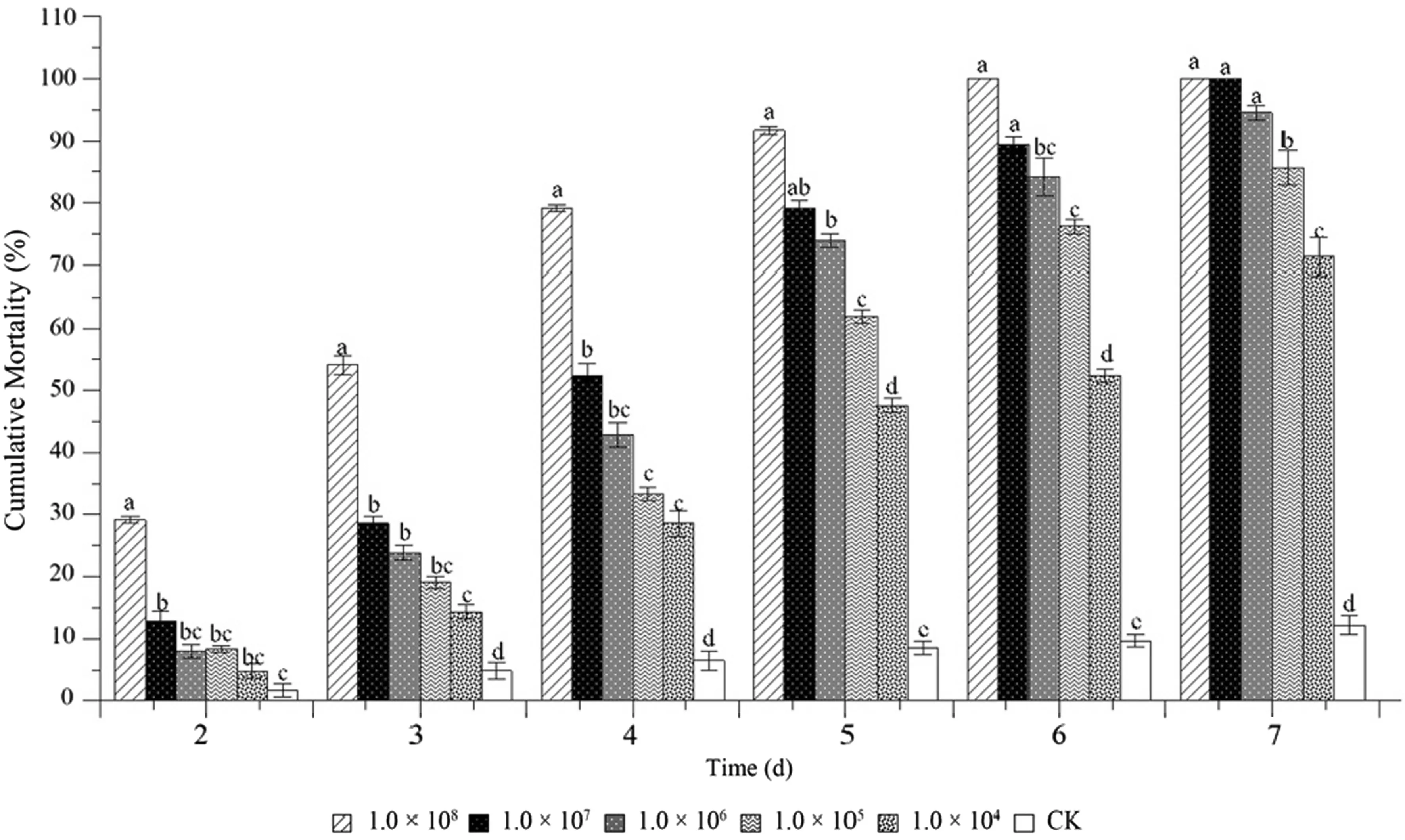
Fig.2 Cumulative mortality of C.lapathi larvae treated with different concentrations of CFCC81428;bars with different letters indicate significant differences (P<0.05)
The LC50of strain CFCC81482 from the 2nd to the 7th days was 2.75×1010,1.63×108,1.61×106,1.36×104,6.47×103and 1.58×103conidia mL-1,respectively (Table 3).
Cumulative mortality and LC 50 of B.bassiana strain CFCC83116 to C.lapathi larvae
The mortality ofC.lapathilarvae treated with different concentrations ofB.bassianastrain CFCC83116 are shown in Fig.3.C.lapathilarvae mortality was positively correlated with increasing time of treatment and spore suspension concentration.From the 4th to the 7th day,the cumulative mortality rate of the CFCC83116 suspension was significantly different compared with all other concentrations (P<0.05) except for 1.0×106and 1.0×105conidia mL-1.The CFCC83116 strain at 1.0×108conidia mL-1suspension reached 100%mortality on day 7.The cumulative mortality rates from the 1.0×107to 1.0×104conidia mL-1suspensions were 94.4%±1.2%,83.3%±1.7%,77.2%±2.1%,and 55.5%±2.9%by day 7,and were less effective than the strain CFCC81428 in all concentrations.
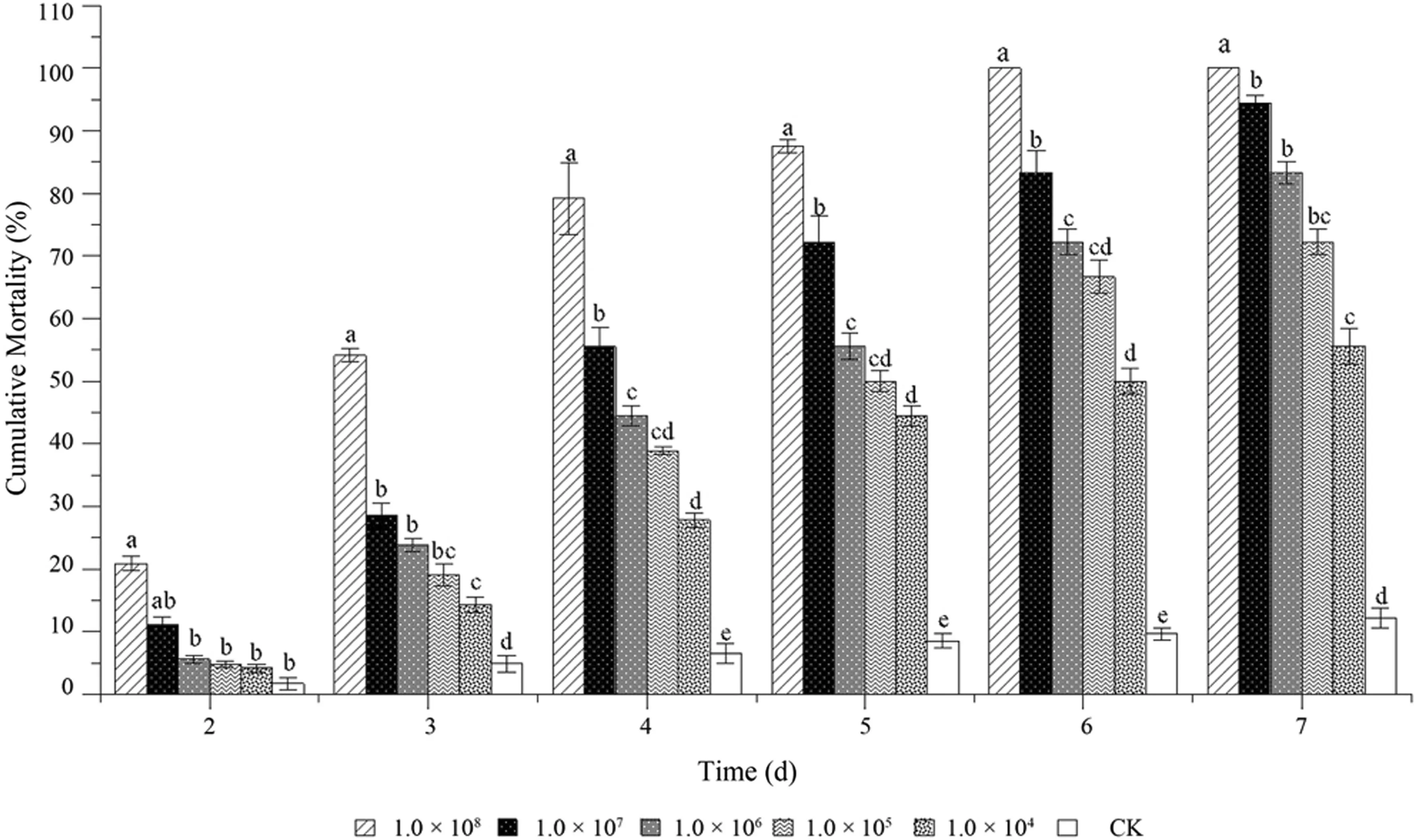
Fig.3 The cumulative mortality of C.lapathi larvae treated by different concentrations of CFCC83116;bars with different lowercase letters indicate significant differences (P<0.05)
The LC50of strain CFCC83116 from day 2 to day 7 were 1.82×1012,3.42×108,6.93×105,1.01×105,1.95×104and 5.07×103conidia mL-1,respectively (Table 4).
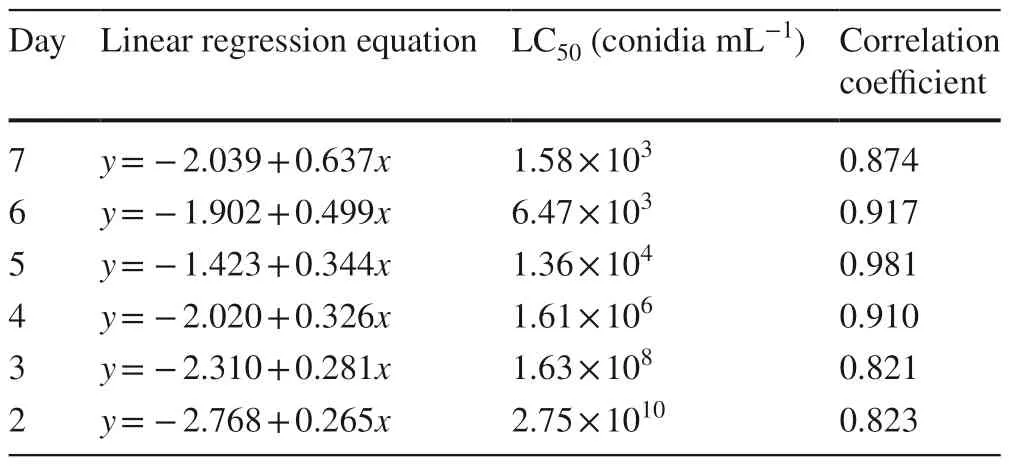
Table 3 LC50 of C.lapathi larvae with different treatment times of CFCC81428

Table 4 LC50 with different treatment times of CFCC83116 to C.lapathi larvae
Cumulative mortality rates and LC 50 of B.bassiana strain CFCC87298 at different concentrations
C.lapathilarvae cumulative mortality rate was positively correlated with increasing treatment time and the suspension concentration (Fig.4),exhibited a significant difference (P<0.05) from 1.0×108to 1.0×106conidia mL-1between the 4th and the 5th days.At seven days after treatment,the CFCC8728 resulted in 100% mortality in 1.0×108conidia mL-1.The cumulative mortality rates from the 1.0×107to 1.0×104conidia mL-1suspension was 88.9%±1.2%,77.8%±3.1%,61.1%±2.3% and 55.5%±2.3% by day 7,respectively.
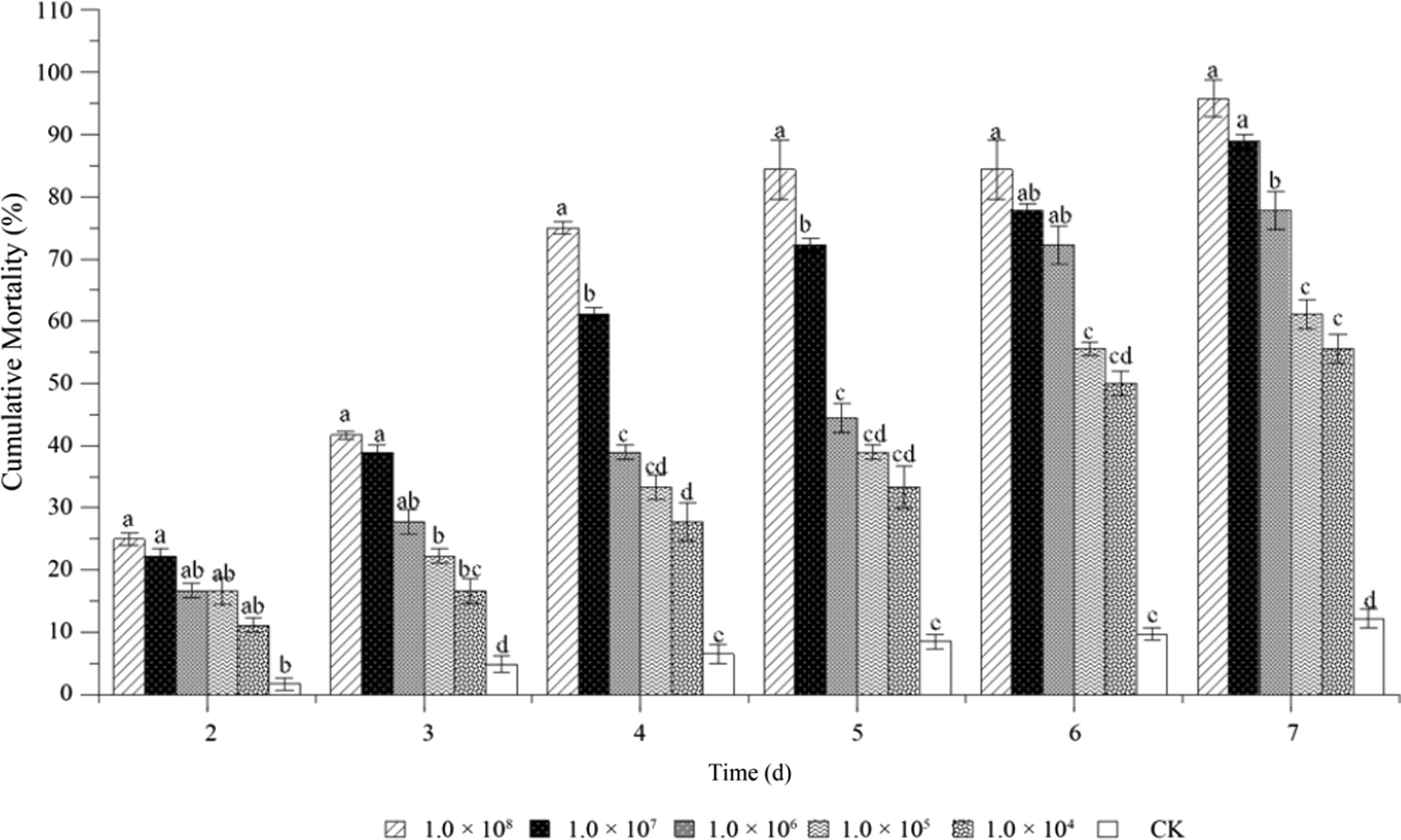
Fig.4 The cumulative mortality of C.lapathi larvae treated by different concentration of strains CFCC87298.Bars with different lowercase letters indicate significantly different (P<0.05)
The LC50of strain CFCC87298 from day 2 to day 7 were 8.09×1012,2.22×108,2.37×106,5.38×105,7.57×103and 5.20×103conidia mL-1,respectively(Table 5).

Table 5 LC50 with different treatment times of CFCC87298 to C.lapathi larvae
Effects of pathogenicity by screening the high virulent strains to C.lapathi larvae at different concentrations in the two trial plots
The cumulative mortality of the selected high virulent strains at different concentrations is shown in Fig.5.The infection status ofC.lapathilarvae in the field survey are shown in Fig.6.The cumulative mortality rate due to the CFCC81428 strain was significantly higher than for the other two strains and the controls at all concentrations in both Beipiao and Lindian.The adjusted mortality from the CFCC83116 strain in Beipiao were 69.1%,59.1%,54.0%,31.8% and 22.2% at 1×108,1×107,1×106,1×105and 1×104conidia mL-1,respectively,which was slightly higher than in Lindian at 66.5%,56.0%,47.4%,28.5%,14.6% respectively.All the concentrations of CFCC83116 resulted in higher mortality rates than those of strain CFCC87298 but lower than those of strain CFCC81428 in both test plots.The cumulative mortality showed an increasing trend with increasing concentrations.When the concentrations exceeded 1×106conidia mL-1,the mortality rate of these three strains exceededs 50%,except for CFCC87298 at 1×106conidia mL-1.In addition,the CFCC81428 strain showed the highest cumulative mortality rate at 82.2%±4.23% and 77.6%±5.12% at 1×108conidia mL-1in Beipiao and Lindian,respectively.This means that the CFCC81428 strain was more effective than CFCC83116 and CFCC87298.The pathogenicity of each strain was positively correlated with its conidia concentrations.
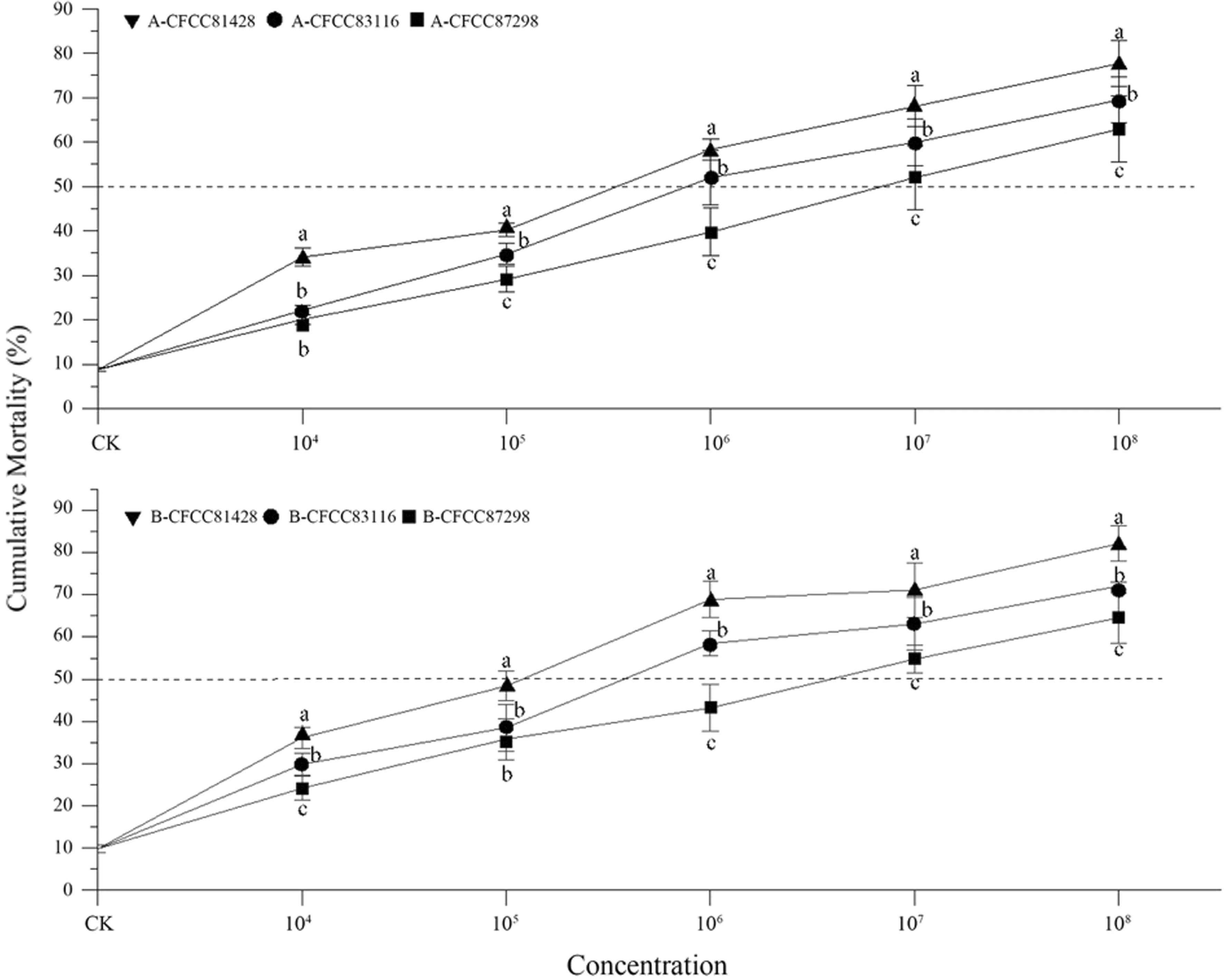
Fig.5 Cumulative mortality of C.lapathi treated by high-virulent strains (CFCC81428,CFCC83116,CFCC87298) in Beipiao (B) and Lindian(A);Bar with different lowercase letters indicate significant difference (P<0.05)
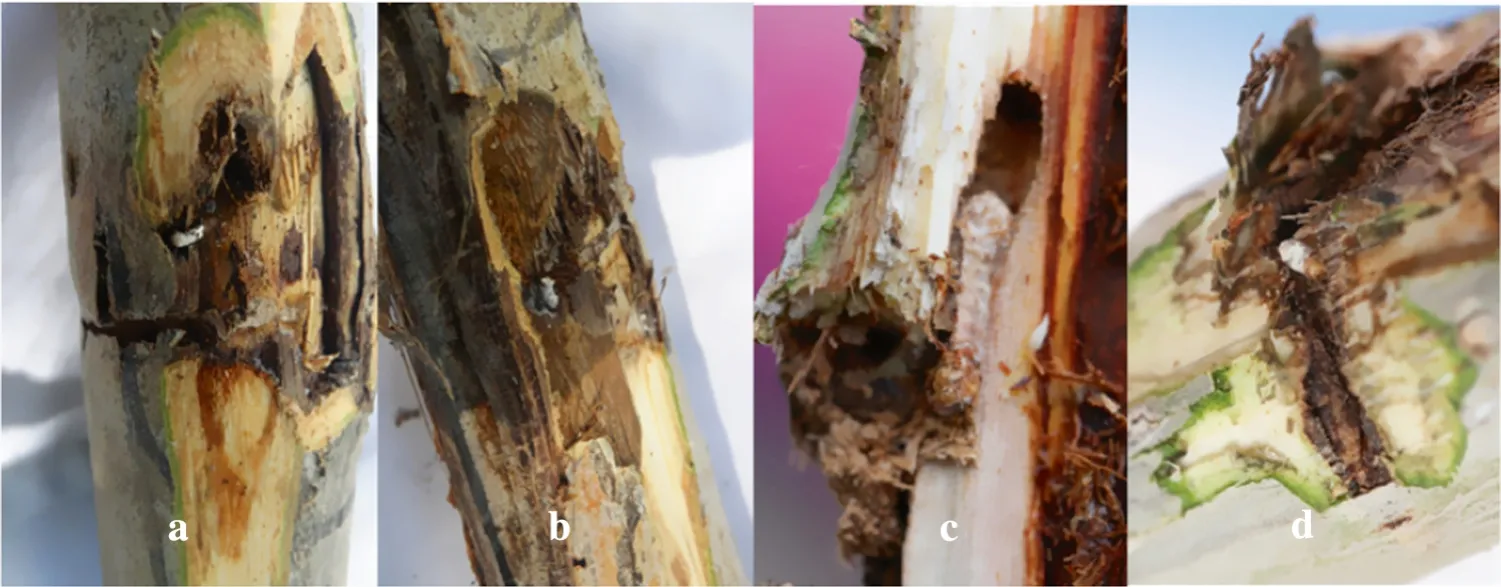
Fig.6 C.lapathi larvae infected with high-virulent B.bassiana strains and the dead larvae remained in the trunk after infection in the field test;a and b (Beipiao),c and d(Lindian)
Discussion
Entomopathogenic fungi (EPF),as biological control agents,are important regulators used in integrated pest management strategies to control pest populations,and are regarded as promising and effective microbial agents taking the place of chemical control measures (Hajjar et al.2015).EPF may have certain advantages over insecticides,such as efficiency and environmental safety (Jiang et al.2019).BeauveriaandM.anisopliaestrains as EPF agents have become the most widely method to control insect pests because of their unique body wall invasion,long persistence,and relatively considerable diffusion effect,a promising feature in the control of pests.They are being used in commercial formulation for mass production (Sani et al.2020),which make its own irreplaceable advantages.BeauveriaandM.anisopliaestrains can infect different species of pest insects as well as Coleoptera pests.For instance,it has been demonstrated thatB.bassianacould cause 100% mortality to the red turpentine beetle(Dendroctonus valensLeConte) at 1×107conidia mL-1(Zhang et al.2011).Hajek et al.(2008) also found thatM.
anisopliaecould affect the fecundity of female Asian longhorned beetles (Anoplophora glabripennisMotschul.)and the survival of next generation larvae.One study suggested thatM.anisopliaecould reduce the number of southern cattle tick (Boophilus microplusLahille) significantly (Alonso-Díaz et al.2007).Barbosa et al.(2018)showed that bothB.bassianaandM.anisopliaeat concentrations of 1×108conidia mL-1triggered a significant pathogenicity onTetranychus ogmophallosFerreira &Flechtmann.BeauveriaandM.anisopliaeas pathogenic fungi could be an environmentally friendly biological strategy to control insect pests.We made similar experiments to infect and controlC.lapathilarvae and evaluated the pathogenicity ofBeauveriaandM.anisopliaeto screen the highly pathogenic strains.
This study showed that the levels of virulence were significantly different among the six fungal strains at a concentration of 1.0×108conidia mL-1.TheB.bassianaCFCC81428 strain resulted in the shortest LT50(2.7 days) and the highest mortality rate (100%) among the six strains.TheB.bassianaCFCC83116,CFCC87298 strains also had satisfactory pathogenicity and their virulence were higher than theB.brongniartiiCFCC83487 andM.anisopliaeCFCC88953 strains.Similar findings were reported by Zhang et al.(2019)who found thatB.bassiana(Bi062) had the highest virulence to the third instar larvae ofHelicoverpa assultacompared to the other threeB.brongniartiistrains,with a corrected mortality reaching 91.1% within ten days and the lowest LT50value was 4.7 days.TheM.anisopliaeCFCC88953 strain had the lowest mortality (66.7%±2.9%) and longest LT50(4.7 days) among the six fungal strains.This was in agreement with that of de la Rosa et al.(1997) who demonstrated the pathogenicity of nine strains ofB.bassianaand five ofM.anisopliaeagainst the coffee berry borer,Hypothenemus hampeiBetrem,and found thatB.bassianastrains had stronger pathogenicity thanM.anisopliaestrains with LT50values of 5.3 and 5.8 days,respectively.
TheB.bassianastrains CFCC81428,CFCC83116 and CFCC87298 resulted high cumulative mortality and low LT50,and were screened as the high-virulent strains.These three strains were all isolated from the Cerambycidae or long-horned beetle family,and the reason they showed highvirulence might be due to the closer relationship between the Cerambycidae and Curculionidae family of true weevils.The good pathology ofB.bassianastrains to theC.lapathilarvae illustrate that the compatibility of pathogenic fungi with pests is considerable (Sevim et al.2010),and this has broadened the research scope.However,the problem lies in the different pathogenicity levels of different pathogenic fungi against different pests.Screening out highly pathogenic and specific pathogenic fungi with target insect pests is a key prerequisite for the development of successful microbial preparations (Myrand and Buffet 2015).In this research,the pathology of the three high virulent fungi varied at different concentrations,and the cumulative mortalities are positively correlated with the increase of treatment time and concentrations.Alagesan et al.(2019) also tested fourB.bassianastrains and their effect on the banana stem weevil (Odoiporus longicollisG.A.K.Marshall) at four concentrations from 105to 108conidia mL-1,and found that the highvirulentB.bassianaisolate KH3 (1×108conidia mL-1) was the most effective againstO.longicollislarvae among other three strains,resulting in > 90% mortality in 12 and 18 days.Larval mortality was greater at a higher concentration in agreement with the findings of the present study.Imoulan and Elmeziane (2014) found that 15 local MoroccanB.bassianaisolates resulted in signif ciant mortality of the larval stage of the Mediterranean fruit fyl,CeratitiscapitataWiedemann.Isolates ERS4.16 and TAM6.2 were the most virulent,causing mortality of 90% and 95%,respectively.A slowly increasing mortality rate occurred from day 5 to day 7 after treatment.A reason might be beauvericin,fusarium mycotoxin,and secondary metabolites produced byB.bassiana,which cause theC.capitatalarvae to trigger a series of immune responses such as humoral and cellular immunity,and begin to establish more and better complete protection mechanisms,for instance,secrete a large number of protective and detoxification enzymes to inhibit the production of hyphae.The virulence of pathogenic fungi,particularly in the formation of an infection structure,host entry and toxin-mediated host death,need to be further studied in depth.Understanding these processes will provide a basis for strain selection and improvement (Clarkson and Charnley 1996).
In this study,it was shown under field conditions,the three high virulenceB.bassianastrains caused lower mortality than the laboratory experiment which was in line with the field trial results ofB.bassianapathogenicity toX.rusticus(Wang and Chi 2019).The same fiveB.bassianastrains were tested against the larvae ofC.lapathiandX.rusticusseparately in Lindian County.The outcome showed different sequences of pathogenicity;CFCC81428 was not the strongest but also showed a relative high virulence toX.rusticus,which indicated that the same strain ofB.bassianacould have a different virulence to other insect pests (Aw and Hue 2017).The lower pathogenicity ofC.lapathitoB.bassianastrains might be restricted by external conditions on spore germination and whether the spores can successfully attach to the weevil.Temperature,humidity and UV resistance are vital factors for fungal spore germination and longevity(Hong et al.1997).Compared to field conditions,eachC.lapathilarvae infected by the diluted spore suspension was incubated at 26°C,75%±10% RH,and in darkness but field conditions cannot guarantee optimum conditions for spore germination.Mann and Davis (2020) tested the pathology ofB.bassianastrains against the spruce beetle,Dendroctonus rufipennisKirby and showed that low ambient temperatures strongly inhibitedB.bassianagrowth.Cheong and Azmi(2020) found that 90% relative humidity could result in the highest efficacy ofRhynchophorus ferrugineusOlivier affected by theM.anisopliaestrain,Met-Gra4.Acheampong et al.(2020) reported that the conidia of fourB.bassianaand threeM.anisopliaestrains could be killed of all isolates with a 2-h exposure and a simulated radiation at 0.3 W m-2as fungi strains were highly sensitive to UV radiation.Brushing the diluted spore suspension on the trunk does not ensure adequate contact between theB.bassianastrains and eachC.lapathilarva,and is not the same as laboratory conditions.
The mortality of larvae from Lindian County was lower than that of Beipiao County,but the order of virulence did not change.CFCC81428 was still the most effective;the cumulative mortality rate reached 82.2%±4.23%and 77.6%±5.12% at Beipiao and Lindian,respectively,followed by the CFCC83116 strain (69.1% etc.) and CFCC87298(60.7% etc.).A possible reason for this might be the accumulated temperature differences between the two plots which allowed Lindian larvae to grow faster than Beipiao larvae,which might see some larvae enter the xylem,increasing the difficulty of contact with the diluted spore suspension.Furlong and Groden (2003)indicated that the pathogenicity ofB.bassianavaried according to the developmental degree of the larvae.Sufyan et al.(2019) found that second instar larvae of the spotted stem borer,Chilo partellusSwinhoe,were more susceptible to the microbial treatments than fourth instar larvae under 1×108conidia mL-1ofB.bassiana.The research also indicated that the upsurge of melanin content in the mid gut and cuticle of insects may impede the penetration of the fungal germ tube in larger larvae instars.Other conditions such as air humidity may also cause different spore germination dissemination.The specific reasons need to be further determined.
Changing the use of biological insecticides to replace chemical insecticides in forestry enterprises is not an easy matter.There are complex checks and balances between entomopathogenic fungi and insect pests,especially under field conditions which can be affected by numerous factors.Screening highly effective pathogenic fungi to replace chemical insecticides which is particularly important to determine whether fungal agents can be commercially produced in large quantities with economic benefits.Most importantly,whether the fungal agents are effective in infecting the target insect under the ecological conditions requires long-term research (Jackson et al.2009).
In this study,under laboratory and field conditions,theB.bassianaCFCC81428 strain had the strongest virulence and needs to be further investigated as a possible biological control agent againstC.lapathilarvae.More research is needed to improve the stability of pathogenicity and tolerance to the environment in field conditions.Oliveira et al.(2 018) found that emulsifiable oil-based formulations could protect the conidia ofB.bassianaandM.anisopliaefrom the adverse effects of high temperatures before spraying in the field.Kaiser et al.(2020)indicated that the combination ofB.bassianaand colza oil increasedBrassica napusL.mortality more than expected from the additive effect of single applications,showing a strong synergistic effect.These may help to improve the stability and enhance the pathogenicity ofB.bassianaCFCC81428 In these results,theB.bassianastrain of CFCC81428 as a biological insecticide has the potential to controlC.lapathilarvae.
Conclusions
Our results indicate that the CFCC81428 strain was the most virulent,followed by CFCC83116 and CFCC87298 strains,which shows an ideal pathogenicity againstC.lapathilarvae in both laboratory and field conditions.CFCC81428 has the potential to be a biological agent to controlC.lapathilarvae.
AcknowledgementsThis research was conducted with the assistance of the Beipiao and Lindian Forest Pest Control and Quarantine Stations.We thank all the staffworking in those two stations for their support.
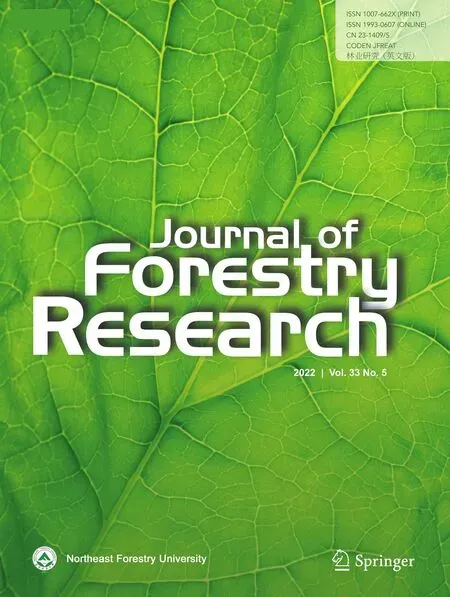 Journal of Forestry Research2022年5期
Journal of Forestry Research2022年5期
- Journal of Forestry Research的其它文章
- Correction to:Morphological and phylogenetical analysis reveals that a new tapeworm species (Cestoda:Hymenolepididae)from whooper swan belongs to Cloacotaenia not Hymenolepis
- Correction to:Within-and between-population variations in seed and seedling traits of Juglans mandshurica
- Correction to:Effects of chemical sterilization of the culture media,porous membranes and luminosity on in vitro culture of Eucalyptus grandis ×Eucalyptus urophylla
- Carbon sequestration in biomass and soil following reforestation:a case study of the Yangtze River Basin
- Monitoring spatiotemporal soil moisture changes in the subsurface of forest sites using electrical resistivity tomography (ERT)
- Variations in growth traits and wood physicochemical properties among Pinus koraiensis families in Northeast China
